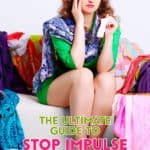The Ultimate Guide to Stop Impulse Buying

If you are someone who is an impulse spender, then you are not alone. Canadians spend almost $9 billion on impulse shopping every year. This ultimate guide to stop impulse buying has 17 actional tips to help you shift your behaviour and save more money.
What Is Impulse Buying?
Impulse buying is making a purchase or multiple purchases that are unplanned. If you’re spending on something that is not in your budget, then that product is an impulse buy.
Impulsive vs. Compulsive Buying
The difference between impulsive and compulsive buying has to do with the motivation behind the shopping experience.
Impulsive shopping is unplanned and a response to an external trigger. This external trigger can be a sale sign or having lower-cost products available while you wait in the checkout line.
A compulsive purchase is more internally motivated, planned, and made to avoid or relieve certain emotions such as anxiety or stress. When you think of the term retail therapy, it often relates to compulsive buying.
Impulse Buying in Canada
According to a June 2018 survey conducted by Finder.com, 63% of Canadians admitted to making an impulse purchase at least once within the past year. This accounts for $8.8 billion of annual impulse spending.
The average spending per impulse buy was $73.81, with Baby Boomers only spending $64.90 and Gen Xers spending $80.07.
On average, Canadian shoppers made an impulse purchase 6 times a year, with the Prairie provinces being the most impulsive.
The survey found that 69% of female shoppers and only 56% of male shoppers bought something unplanned. And while men made up a smaller percentage overall, their average spend was $80.46, while women only spent $69.27.
Our American neighbours are much more impulsive shoppers. 89% of Americans admit to being an impulse shopper within the last year. This accounts for $23.09 billion in annual impulse spending.
How To Stop Impulse Buying
The following is a list of 17 strategies to help curb your impulse buying. But don’t try to do them all at once. It will be too easy to feel overwhelmed and want to give up.
Instead, try one or two strategies at a time. And keep experimenting until you find the right strategies that work for you.
Make a Budget and Stick to It
An essential thing you can do to prevent yourself from becoming an impulse shopper is to make a budget and stick to it. There are many budgeting apps out there that can help you do just that.
Creating a budget isn’t about depriving yourself. It’s about giving each dollar a role and allocating money for things that bring you joy or enhance your well-being.
Build Flexibility and Fun Money Into Your Budget
As important as creating a budget is, it is also vital to build flexibility into your plan by including a fun money category. Fun money is money that you can spend on anything you want, even the odd impulse item.
The benefit of having flexibility is it gives you breathing room. You won’t feel restricted by your money plan if you have some money set aside for random or spontaneous purchases. Just make sure not to overspend in your fun money category.
Shop With a List and Stick To It
Admittedly this is one thing that I am terrible at. I often make a list but then buy products that aren’t on it.
By creating a list and sticking to it when you’re shopping, you eliminate the urge to buy random items.
Take some time before you go shopping to determine what exactly you need. Then make sure that you have enough money in your budget to cover the cost of the items. From there, as long as you stick to the shopping list, you should be good to go.
Try a No-Spend Challenge
No-spend challenges can run for however long you like, with one month being a typical time frame. That doesn’t mean that you can’t spend any money during that month.
For a no-spend challenge to be practical, you determine what categories you can spend money on and which ones you can’t. For example, food and groceries may be a permitted spending category, but clothing may not.
Creating a challenge for yourself can be very motivating. Ask a few friends to join you and make a group activity out of it.
Become a Cash Only Spender
One way to curb your spending is to only spend in cash. If you have created a budget, then you know how much money you have allotted for each category. At the beginning of the month, you can take out the cash you will need and then only spend that cash throughout the month.
Using the cash envelope system goes well with this strategy. By spending in cash, it is more difficult to overspend. When the envelope is empty (or there is no more cash), then you have nothing more to spend.
Only Shop With the Cash You Need
If you do all of your shopping in cash, then only take the money you need when going out. Taking more money than required for that specific shopping trip (or list) will tempt you into spending it unnecessarily.
By creating a list and then only bringing the cash you need, you can help prevent yourself from impulse buying items that are not on the list.
Have Separate Chequing and Savings Accounts
By keeping your chequing and savings accounts separate, you are more likely to save and less likely to spend. If you don’t see that money sitting in your chequing account, then you may forget about it and won’t spend it.
Take this one step further and have your chequing and savings accounts at separate banks. This helps make it easier to save and harder to spend.
Automate Your Savings – Pay Yourself First
To take the previous tip one step further, once you know how much you can save every month, set up an automatic transfer to your savings account on payday.
By paying yourself first, you ensure that your money is getting saved and not spent. Having less money available should help prevent you from being an impulse buyer.
Detach Your Savings Account From Your Debit Card
If you have set up your chequing and savings accounts at various banks, then your savings account should not appear on your debit card. But if you have your chequing and savings accounts at the same bank, the first step you can do is detach your savings account from your debit card.
That way, when you go to use your debit card, you won’t be able to dip into your savings. If you don’t have the money in your chequing account, then you can’t spend it.
Avoid Impulse Buy Temptations
It is easier to stop impulse buying if you don’t put yourself in a position to purchase. Avoid tempting environments like going to the mall “just to look around” or scrolling through your favourite online shopping stores during your lunch break.
Shopping environments are designed to turn you into an impulse buyer. By avoiding these tempting environments, you can keep more of your hard-earned money in your pocket.
Unsubscribe From Email Lists
Do you get multiple emails a day from your favourite stores? If so, you need to unsubscribe from those email lists. Those constant emails are temptations and catalysts for impulse buying.
Unsubscribing from those email lists will make it less likely that you feel the “need” to buy something just because it’s on sale.
Remove Your Login Information From Apps and Online Stores
Create a small purchasing barrier for yourself by removing your login information from apps and online stores. The extra few seconds (or minutes if you have to find your password) it takes to put in your login information can be just enough time for you to stop and pause.
During this stop and pause, ask yourself if this item is something you need or are you impulse shopping?
Adopt the 24-Hour or 30-Day Rule
If the short pause of inputting your login information isn’t enough to stop impulse buying, then maybe you need to adopt the 24-hour or 30-day rule.
For both of these rules, whenever you want to buy something (that is not essential like groceries), you put that item on a list. And then wait for either 24-hours or 30-days. If you still think you need the item (and have money for it in your budget), you can go ahead and buy it.
By waiting, you are no longer an impulse buyer. You have given yourself time and space to contemplate the purchase.
Freeze Your Credit Cards
If credit cards are your Achilles heel when it comes to impulse buying, then freeze them in a block of ice. That way, when you want to buy something, you will have to wait for the ice to melt before you can use your credit cards.
The time it takes for the ice to melt may be just enough time for you to think about the impulse buy and if you want to make it or not.
Download Plugins To Freeze Your Online Cart
Freezing your credit cards is not for everyone. But there are plugins you can download for your internet browser that will freeze your online shopping cart.
With these plugins, once you put something into your online shopping cart, it will not let you impulsively buy it—your shopping cart freezes for a set amount of time.
One downside of these plugins is that they can become super annoying when making purchases for your actual needs.
Avoid Being an Emotional Spender
Emotions often play a large part in impulse buying.
One tip is to not grocery shop when you are hungry. When you do, you’re more like to buy impulse items because you’re hungry and just want to eat them right now.
Other emotions (such as excitement or anxiety) can also impact our shopping habits, so it’s best to avoid shopping when you are emotional, either positively or negatively.
Focus on Your Goals
Focusing on your goals and how important they are to you can help prevent you from spending money on stuff that doesn’t bring you closer to your goals.
Keep your goals written down in plain sight so that they are always on your mind. Better yet, keep them in your wallet to help remind you to focus on them and not unnecessary spending.
Calculate the Hourly Cost of the Impulse Buy
One way to make the feeling of spending money more concrete is to calculate how much an item costs you in time. If your hourly rate is $25 an hour, you would have to work for 3 hours to pay for the average Canadian impulse buy. And that doesn’t include taxes.
Create Space
Many of the above strategies focus on creating space between the urge to purchase and buying the product. When we make it easy to spend our money, it is easy to become an impulse shopper.
The more space you can create between the urge to purchase and making the purchase, the less likely you will be to impulse shop.
Eliminating impulse buying is not about never spending money. There is nothing wrong with spending money. Just make sure to spend it on things that contribute to your well-being and bring you value.

